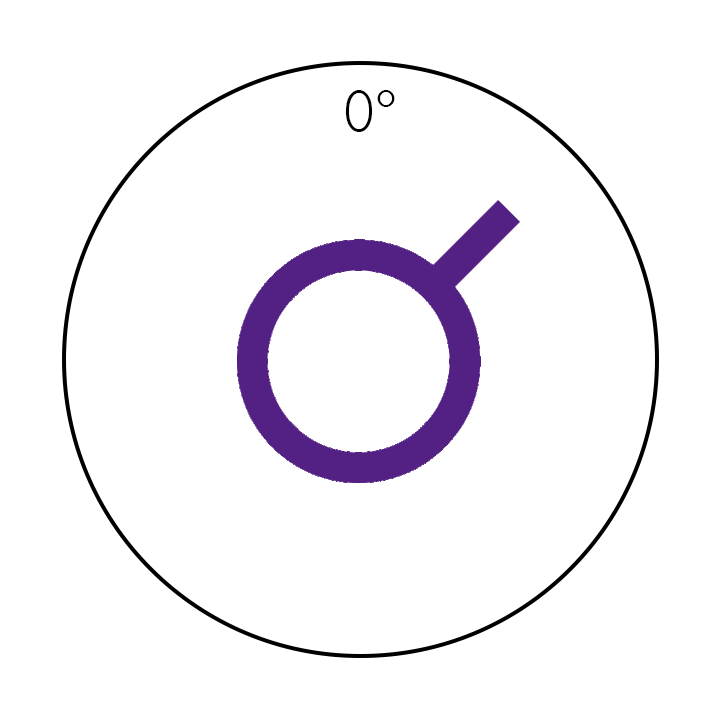Every birth chart is a circle, which is, of course, made up of 360 degrees. Each planet occupies a specific degree of the circle. The angles the planets form to one another in the chart—the aspects—describe the relationship between those planets.
In Astrology, the square and opposition indicate hardships, while trines are seen as blessings. Yet, without the challenging aspects, the so-called easy aspects have little value.
When interpreting aspects, the Astrologer must be careful to note which kinds of aspects are most prominent.
For instance, it's necessary to consider the "orb," or how close the aspect is to its exact degree. Although it is traditional to use an orb of 8°-10° for the aspects listed below, the smaller the orb—the more exact the angle—the more significant the aspect.
One of the keynotes of Modern Astrology is the belief that we need challenge in our lives in order to learn, the goal being to cultivate deeper understanding & awareness of our easy aspects (talents) to successfully overcome the hard aspects (challenges). This process of self-awareness is what leads the individual to true growth and feelings of accomplishment.
Here I’ll outline what most Astrologers consider to be the “major,” or most relevant, aspects in interpreting a chart.
The Conjunction: Intensity
A conjunction occurs when two planets sit within the same degree of one another in a chart. Usually both planets fall in the same sign and house, placing an emphasis on that sign and house; yet there are cases in which planets can be conjunct yet span two signs and/or houses.The key theme of the conjunction is the inherent inseparability of the two planets involved. In other words, the two planets act as a single unit. For example, in the case of a Venus-Mars conjunction, sexual love and romantic love are seen instinctively as one and the same. Similarly, the qualities that turns the person on romantically would be the same qualities or personality type that would turn them on sexually as well.
The Sextile: Opportunity
The Sextile: Opportunity
A sextile, or 60° angle, formed between two planets in a chart indicates “opportunity.” The type of opportunity will be indicated by the planets forming the aspect and what signs/houses those planets fall in. If the sextile is formed between two planets in “yin” (Earth or Water) signs, it will be an opportunity that falls into the person’s lap. A sextile between two planets in “yang” (Fire or Air) signs, on the other hand, will be an opportunity that the person creates for themselves. The sextile is similar to the opposition in that both aspects highlight the free will of the individual: an opportunity may exist but does the individual have the capacity (as indicated by other factors in the chart) to take advantage of it? Maybe yes, maybe no.
The Square: Tension
A square, or 90° angle, formed between two planets in a chart signifies challenge. This challenge manifest in more ways than one, but wherever the source of tension, it is a conflict that demands resolution. The square aspect is unique in that the person is very aware of the particular challenge (as described by the planets, signs, and houses involved), and that it is a part of her life that must be conquered or dealt with in some way. Failure to face the challenge indicated by a square can lead to feelings of frustration or the compulsive repetition of negative behaviors; however, those with squares placed prominently in their chart have the potential for tremendous achievement and strength of character.
The Trine: Ease
A trine aspect is defined by an angle of 120°. A trine occurring between two planets or points in a chart typically occurs in signs of the same element, thus indicating an easy balance of energy. Traditionally, trines have been described as the "best" aspect to see in a chart, as they can be considered our greatest assets: they (trines) enrich our lives because they act as cushions—talents and traits that allow us to attract positive circumstances and ameliorate the stress of the more difficult aspects in the chart. The trine resembles the conjunction in that both can refer to qualities we take for granted or that come so naturally to us that we may not even recognize them. However, the trine is not action-driven like the conjunction and can lead to passivity.
The Opposition: Learning Through Relationships
When two planets are 180° apart, they are considered in opposition to each other. Oppositions connote a feeling of pressure to make decisions in two opposing areas of life. Full Moon babies—those born under an opposition of the Sun and Moon—tend to be quite preoccupied with the question of “need” v.s. “want,” constantly assessing the success of their ability to meet the demands of others with the demands of their personal, private lives. The blessing of this aspect is that it bestows the individual with the capacity for awareness of self and other. Thus a person with oppositions in their chart tends to be very social and gains insight into themselves through relationships with others. The lesson associated with the opposition is that of balance: when one learns how to balance the demands of others with the demands of self, then harmony is achieved.






